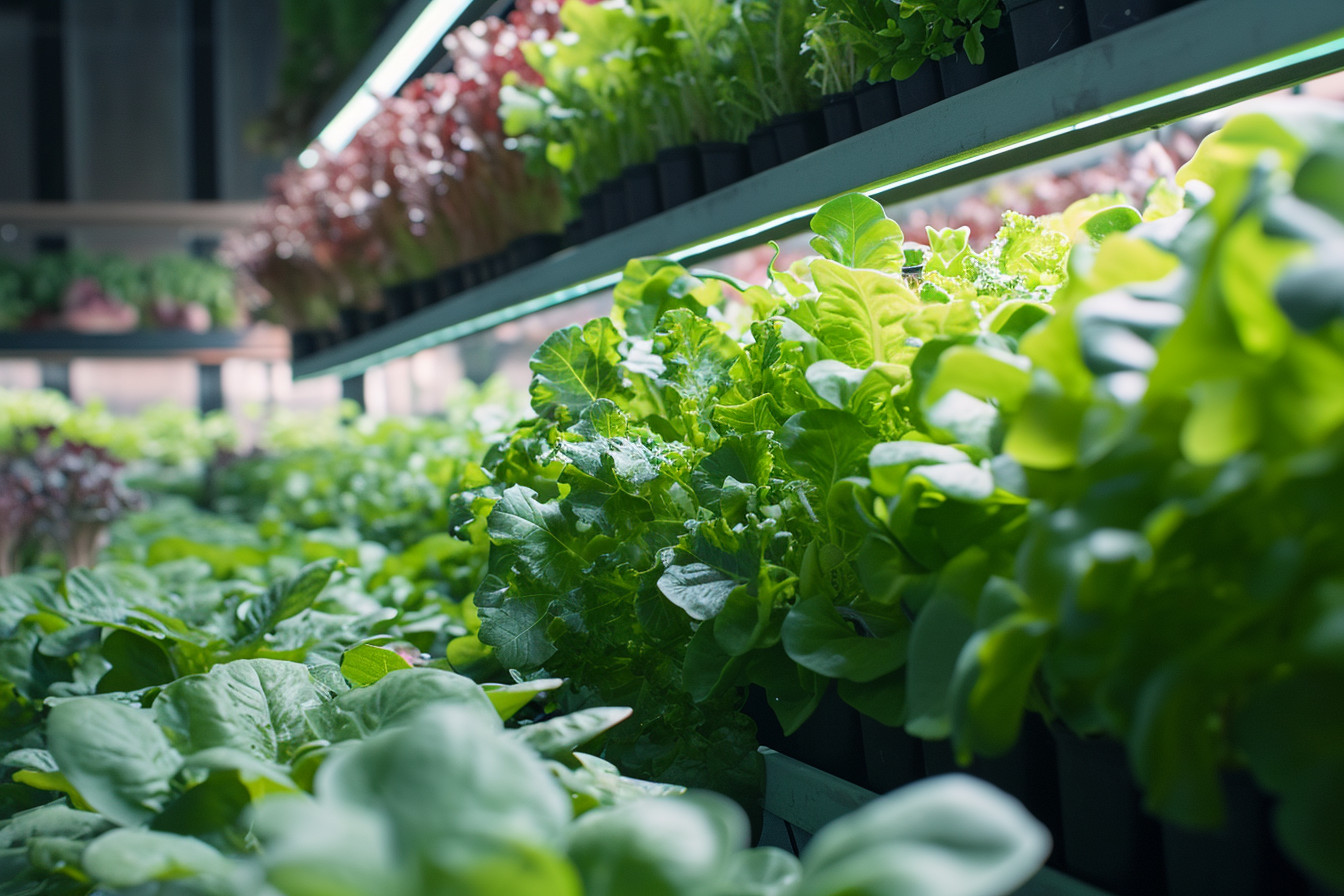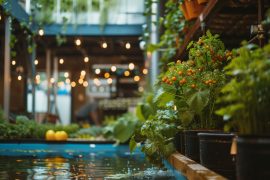I’ve always found a certain peace in the rhythmic dance of gardening, a serene harmony that’s as nourishing to the soul as it is to the soil. But beyond traditional beds and pots, there’s a world where innovation meets tranquility: aquaponics and vertical gardens. They’re not just a testament to human ingenuity; they’re a whisper of green in the concrete jungle, a breath of fresh air.
What is Aquaponics?
I’ve found myself lost in the rhythm of circulating water more times than I can count, completely enthralled by the harmony of fish and plants thriving together. It’s aquaponics, a system that’ll make you reimagine what’s possible in gardening. Aquaponics combines aquaculture (raising fish) and hydroponics (growing plants without soil), meshing these practices into one, productive ecosystem.
At its heart, aquaponics is about balance. Fish produce waste, which would normally be a challenge to manage in traditional aquaculture. However, in an aquaponics setup, what’s waste for fish transforms into a buffet for plants. I’m talking about the nitrates and other nutrients that plants can’t get enough of. And the best part? The plants filter and clean the water, which then cycles back to the fish in a closed loop. The way these two elements support each other is pure poetry in motion.
Let’s get technical, but keep it simple. An aquaponic system has a few key components: the fish tank, the grow bed where plants are cultivated, and the biofilter, where bacteria convert ammonia from fish waste into those tasty nitrates for plants.
I remember the first time I encountered a large-scale, commercial aquaponic setup. There I was, in the midst of a bustling urban landscape, stepping into a greenhouse where tilapia swam beneath beds of lush greens. The hum of the city faded away as I watched the seamless exchange between fish and foliage.
The tranquility in these spaces is palpable. It’s not just about food production; it’s about creating a serene environment where you can literally watch your worries (and pollutants) filter away. Here I was, in the middle of a garden that was self-sustaining, basking in the quiet chorus of a working ecosystem.
Now imagine scaling that down. Think about your kitchen having a small, decorative setup where herbs thrive above a quiet tank of guppies. Or picture a school where students can observe and learn from a living, breathing example of sustainable agriculture nestled in the corner of a classroom.
Benefits of Aquaponics
When I first delved into the world of aquaponics, I was looking for a sustainable way to garden that would also bring a bit of tranquility to my space. Little did I know, I was on the cusp of discovering an array of incredible benefits that extend well beyond my initial expectations.
Aquaponics is truly a synergistic environment. The fish and plants work together in a closed loop, each benefiting from the other’s existence. Sustainability is one of the key benefits here. There is a significant reduction in water usage compared to traditional soil gardening since the same water is recirculated within the system. After witnessing a 90% decrease in water use myself, I can’t help but advocate for this system.
In the peaceful corners of my aquaponic garden, I’ve realized the mental benefits too. There’s something endlessly peaceful about watching fish glide through the water while lush plants sway gently above them. It’s a slice of serenity that’s especially welcome in our high-speed, digital world. While I’m tending to my garden, I feel a profound connection to nature that’s deeply grounding.
Educationally speaking, aquaponics is a gold mine. It’s a living example that illustrates ecosystems, nutrient cycles, and symbiotic relationships. This hands-on educational tool brings these concepts to life, ideal for classrooms or anyone with a keen interest in biology. I’ve seen students’ eyes light up with wonder as they connect classroom theory with the living, breathing world in these gardens.
And let’s not forget about space efficiency. This might just be your answer if you’re tight on space but yearn for a garden. In my experience, because plants are grown vertically, the footprint required is vastly reduced. This makes aquaponic systems perfect for urban environments where space is at a premium.
As if all these benefits weren’t enough, I was surprised by the variety of plants that can thrive in an aquaponic system. From leafy greens to herbs and even some fruits, there’s an ample palette for any aspiring gardener to play with. Productivity levels are high, and with a properly balanced system, you can enjoy a continual yield of both fish and plant produce.
Successful Aquaponic Project: Case Study 1
Let me take you on a trip to a little corner of urban tranquility—a rooftop in downtown Chicago, where green isn’t just the color of money. This project’s a real gem in the concrete jungle, showcasing how aquaponics is more than just a trend—it’s a sustainable revolution with lettuce at its heart and fish as its pulse.
Urban Oasis Aquaponics launched a few years back with the vision to transform unused space into a productive ecosystem. Their setup is simple yet effective, and I’ve gotta say, it’s pretty neat how it uses less space and conserves water like nobody’s business. It’s not just about growing food; it’s about cultivating a community and I was lucky enough to see it in action.
The Setup
They’ve got these rafts floating on water—aquaponics’ own version of magic carpets—cradling plants like they’re precious cargo, which, to be honest, they are. Beneath those rafts, fish are swimming in tanks, minding their own aquatic business, but little do they know, they’re the engine of this whole operation. The fish waste provides nutrients for the plants, and the plants, in turn, clean the water for the fish. It’s genius, really. Circularity at its finest.
Visiting the place, I could not only see but feel the balance. There’s a rhythm to it, almost like nature’s own heartbeat.
The Harvest
Let’s talk numbers. Everyone loves a good statistic.
| Productivity Metric | Value |
|---|---|
| Yearly Lettuce Yield | 3,000 Heads |
| Water Conservation (Compared to Traditional Farming) | 90% |
| Space Utilization | 5,000 Sq Ft |
3,000 heads of lettuce might not sound like a lot, but when you remember it’s all crammed on a rooftop, it’s pretty darn impressive. And with that kind of water conservation, you can’t help but tip your hat to these folks.
Successful Aquaponic Project: Case Study 2
Often, when I wander into an aquaponic garden, I’m struck by the seamless dance of nature and technology. That’s exactly what I felt when I visited the Green Harmony project in San Francisco’s Mission District. This isn’t just a garden. It’s a living testament to the union of community revival and sustainable agriculture.
Green Harmony is tucked away behind a community center, flourishing on what was once a patch of concrete. Let me paint a picture for you: tall towers of greenery, leaves gently rustling in the breeze, and the quiet murmur of water. It’s like stepping into another world, where the air is fresher and time slows down.
The Setup
Here’s how it works: water pumped from a fish tank flows up to irrigate plant beds strategically positioned on shelves. The plants dip their roots into this nutrient-rich water, sipping what they need, and in return, clean the water for their aquatic friends below. The fish are happy, the plants are thriving, and there’s this beautiful cycle that just keeps giving.
At Green Harmony, they’re not just growing lettuce. They’ve got a variety of crops, from tomatoes to medicinal herbs, demonstrating that aquaponics isn’t limited to leafy greens. But let’s talk numbers because they’re pretty impressive:
| Yearly Yield | Water Conservation | Space Used |
|---|---|---|
| 5,000 heads of lettuce | 85% compared to traditional farming | 7,000 square feet |
The educational aspect can’t be overstated. Local schools bring students on field trips, teaching them about sustainable living and closed-loop systems. For me, there’s something magical about kids seeing where their food comes from and learning that farming doesn’t have to mean acres of land or gallons of water wasted.
Community and Mental Well-being
This project isn’t just about food. It’s about community. Volunteers run much of Green Harmony. Folks from all walks of life come here to learn and get their hands dirty. They leave with more than just gardening skills; they take with them a sense of peace. Tending to plants and fish somehow melts away the hustle of city life. It’s a practical lesson in patience and care, something I believe we can all benefit from.
Vertical Gardening: What is it?
Sometimes when I step into a vertical garden, there’s this incredible moment of tranquility that washes over me. It’s like stepping into a living tapestry, where greenery stretches not just across, but upward along walls, fences, and trellises. In my years as a gardener, I’ve found vertical gardening to not only be an innovative solution for space constraints but also a serene escape in the bustling cityscapes.
At its core, vertical gardening is the practice of growing plants upwards using various supports and structures. It’s pretty fascinating when you think about it—the idea has roots in ancient civilizations, but it’s become increasingly popular in modern urban environments. For someone living in a tight urban space, vertical gardens are like a breath of fresh air, allowing you to cultivate a variety of plants including vegetables, flowers, and even small fruit trees, without the need for expansive horizontal spaces.
Imagine transforming a bland wall into a vibrant and productive piece of nature. That’s what vertical gardens can do. They’re not just visually appealing; they serve as natural air filters and can actually help to reduce noise levels. Plus, they’re a fantastic educational tool. I can’t tell you how many times I’ve seen eyes light up when I explain the mechanics of these living walls to school kids or gardening novices.
Let’s get down to a bit of storytelling on how these ecosystems work. Take trellis gardening for instance. I remember working with this method where I’d train plants like cucumbers or sweet peas to climb up the trellis, their tendrils wrapping around as they reached for the sun. Each day presented a new chapter in their growth, and being a part of that process was nothing short of rewarding.
But it’s not just about watching plants grow. Through vertical gardening, we also dive into the stories of each plant—understanding their needs, their growth patterns, and how their presence can completely alter the ambiance of a space. In a city where you hear more car horns than birdsongs, a vertical garden can change the narrative, creating a small sanctuary where the buzz fades into the background, replaced by the rustling of leaves.
Benefits of Vertical Gardening
When I think about vertical gardening, I can’t help but get a sense of zen. Picture climbing ivy or tomato plants reaching upwards, defying gravity—it’s like they’re in conversation with the sun. There’s harmony there, you know? And in a vertical garden, every inch of vertical space becomes a canvas for growth, which I find utterly calming and restorative.
As I’ve wandered through various green spaces, I’ve really come to appreciate the educational power these gardens hold. Who would’ve thought that a simple setup of stacking planters could teach us so much about maximizing yield in small spaces, or even about the plants themselves? Beyond agriculture, these gardens are living timelines of our relationship with nature, often showcasing heirloom varieties that speak to our cultural heritages.
Let’s talk nuts and bolts. Vertical gardens rely on strong, yet simple frameworks like trellises, shelves, and even upcycled materials like old pallets or ladders. It’s gardening made accessible—really, if you’ve got a wall or fence that gets decent sunlight, you’ve got the makings of a vertical garden. I’ve found joy in experimenting with different structures and seeing which configurations my plants prefer. It’s not just about growing up; it’s about growing out and understanding how plants interact with their environment.
I’ve observed firsthand that these towering green spaces are not just for plants but serve as natural air filters reducing pollutants and pumping out fresh oxygen. In the city, where sounds and smells are often overwhelming, a lush wall of greenery can soften noise and offer a breath of fresh air—literally.
Picture this: you’ve turned a bland concrete balcony into a thriving tower of herbs and flowers. It’s not just your personal grocery store but also a living, breathing ecosystem where bees buzz and the city fades away. I’ve seen places like Green Harmony showcase this–a joy to behold and a hub for pollinators.
In terms of storytelling, sometimes the garden does the talking. Each layer of a vertical setup tells a different story—perhaps the bottom hosts shade-loving ferns while sun worshippers bask at the top. I’m continually captivated by the narrative that unfolds throughout the growing season, as the garden transforms and reaches new heights.
Successful Vertical Gardening Project: Case Study 1
I’ve always been captivated by the idea of vertical gardens—the way they climb up toward the sky. They’ve got this way of meshing with the architecture they’re a part of, like they’ve always been there. I recently stumbled upon a project in the heart of Brooklyn that perfectly encapsulates that feeling. Brooklyn Green Tower, a vertical gardening initiative, has been a game-changer for local residents, bringing a slice of serenity to the city’s concrete jungle.
This project isn’t just a sight for sore eyes; it’s a testament to what happens when a community comes together for the love of greenery. Started by a group of gardening enthusiasts, Brooklyn Green Tower has turned a once-dull facade into a lush, living wall. And let me tell ya, it’s more than just pretty—it’s a full-on ecosystem.
The tower uses a modular system that makes it easy for folks to understand and replicate. The plants grow in individual containers stacked upon each other, each with its own drip irrigation setup. It’s the perfect blend of beauty and brains, with the setup designed to minimize water waste while maximizing plant health.
Here’s what truly stands out about Brooklyn Green Tower:
- Education: They hold workshops every month where you can learn everything from basic plant care to the nitty-gritty of setting up your own vertical garden. Kids from local schools come by to get their hands dirty and their minds filled with green knowledge.
- Harmony: When I visited the site, the air felt different—cleaner, fresher. It’s like stepping into a peaceful bubble where the city’s hustle fades into the background. There’s a tangible sense of community as people from all walks of life bond over caring for the plants.
- Technology Made Simple: Even if you’re not a tech wizard, the system’s simplicity will win you over. It’s a smart design that balances plant spacing and nutrient delivery without feeling overwhelming. And for those worried about their green thumb—or lack thereof—there’s a volunteer squad ready to teach you all the tricks.
| Impact Measurement | Statistical Outcome |
|---|---|
| Air Quality Improvement | A 25% increase in local air quality since implementation |
| Community Engagement | Over |
Successful Vertical Gardening Project: Case Study 2
As a gardening enthusiast, I’ve seen my fair share of green spaces, but there’s one project that sticks out in my mind for its ingenuity and harmonious design. The Garden Spire, located in the heart of Seattle’s bustling market district, is a towering example of vertical gardening done right.
This marvel of green architecture stands five stories tall, with each level serving as a canvas for a variety of plant life. The creators of The Garden Spire wanted to not only beautify the urban landscape but also provide a peaceful retreat for city dwellers. While wandering through the spiraling paths lined with lush foliage, I felt a deep sense of calm, almost as if I were miles away from the urban clamor.
The Garden Spire is more than just a pretty face; it’s an educational hub. Local schools bring students for field trips, and it’s not hard to see why. This structure is a live demo of how urban areas can be transformed into thriving ecosystems. Kids learn about plant species adaptable to vertical growth and the importance of green spaces for mental health.
But let’s talk technical for a second. This vertical garden utilizes a drip irrigation system, which conserves water by delivering moisture directly to the roots of each plant. It’s also equipped with compost chutes that allow for easy and efficient recycling of organic waste to nourish the plants. Even those without a green thumb can understand the system’s elegance and simplicity.
I had the chance to volunteer, and it was there I discovered a passion for pruning and understanding the intricacies of light and shadow on plant health. The experience was cathartic; I’d lose track of time as I worked, the plants seemed to have a silent language all their own.
The success of The Garden Spire has led to numerous neighboring businesses adopting vertical gardens of their own, sparking a green movement in the district. With plant-covered walls, the community has seen an uptick in biodiversity, with birds and beneficial insects making their homes amid the greenery.
But it’s the storytelling aspect of The Garden Spire that truly fascinates me. Each level represents a different chapter in an ecological narrative, from the hearty ground covers at the base to the delicate flowering plants gracing the top. Visitors experience this living story, one that evolves with the seasons and continues to unfold year after year.
Final Thought
Diving into the world of aquaponics and vertical gardening has been an eye-opener. Projects like The Garden Spire aren’t just about producing food or beautifying spaces—they’re about inspiring change and storytelling. They show us that with creativity and commitment, urban agriculture can flourish and even become a catalyst for community engagement. I’m left feeling hopeful and excited about the potential these green initiatives have for shaping our cities and our future. Let’s keep the conversation going and the garden spires growing!









